Learn how to protect hair under a wig, how to make your hair grow under a wig and what to wear under a wig to keep your natural hair protected.
Wigs are amazing, especially if you have Afro-textured natural hair. They can help you change up your hairstyles without the need for a silk press or hot styling tools.
A lot of women also use wigs when they are growing out their hair by wearing braids or locs or other protective styles and the occasion calls for something different.
However, wearing wigs for a long time can take a toll on your hair and scalp health. The constant friction between hair and wig material is a cause of concern.
Also the accumulation of sweat, grime and scalp’s natural oils between underneath the wig (especially during hot summer months can be a problem.
I’ve faced so many of these issues myself including dandruff, scalp acne, and even breakage due to my inexperience in wearing wigs the right way.
So I’ve got this article for you to help you learn how to protect hair under a wig.
Related: What Wig Density Should You Choose
How To Protect my Hair Under A Wig
If you want to protect your hair underneath a wig, make sure you follow these tips religiously.
Regularly Shampoo Your Hair And Keep Scalp Clean
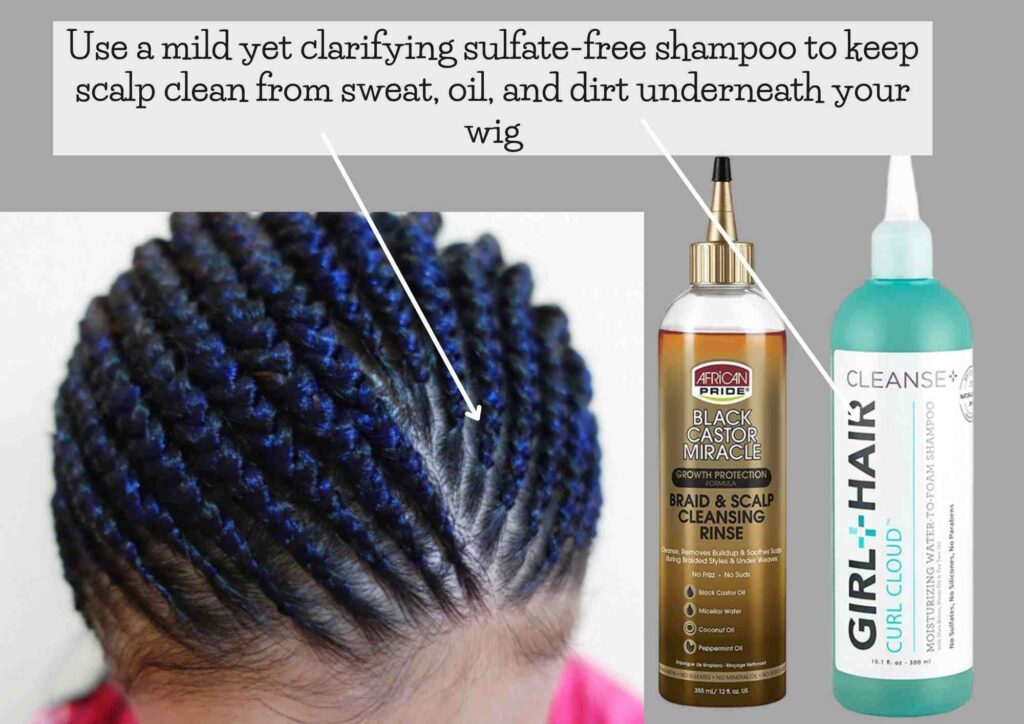
The main issue wig-wearers face is having to deal with a sweaty scalp. But that’s not all, a wig can trap scalp sebum, product build-up, dirt and grime leading to several scalp issues.
If you have an oily scalp on top of it, these problems can be exacerbated.
I’ve noticed that dandruff, scalp acne (due to clogged hair follicles), smelly scalp, and itchiness are often associated with long periods of wearing wigs.
So it’s best to wash your hair often and keep your scalp clean as much as possible.
I would suggest using a clarifying shampoo that has strong cleansing properties with ingredients like activated charcoal, tea tree oil, or glycolic acid that can remove layers of oil and debris from your scalp.
And since you might have to wash your hair more often than usual if you’re wearing a wig, I’d always recommend going for a sulfate-free shampoo.
You don’t have to take your braids out for washing. There are several products designed specifically to wash your scalp while also tightening dreadlocks.
The main concern is to keep your scalp clean and free of oil and sweat accumulation.
Keep Your Hair and Scalp Moisturized
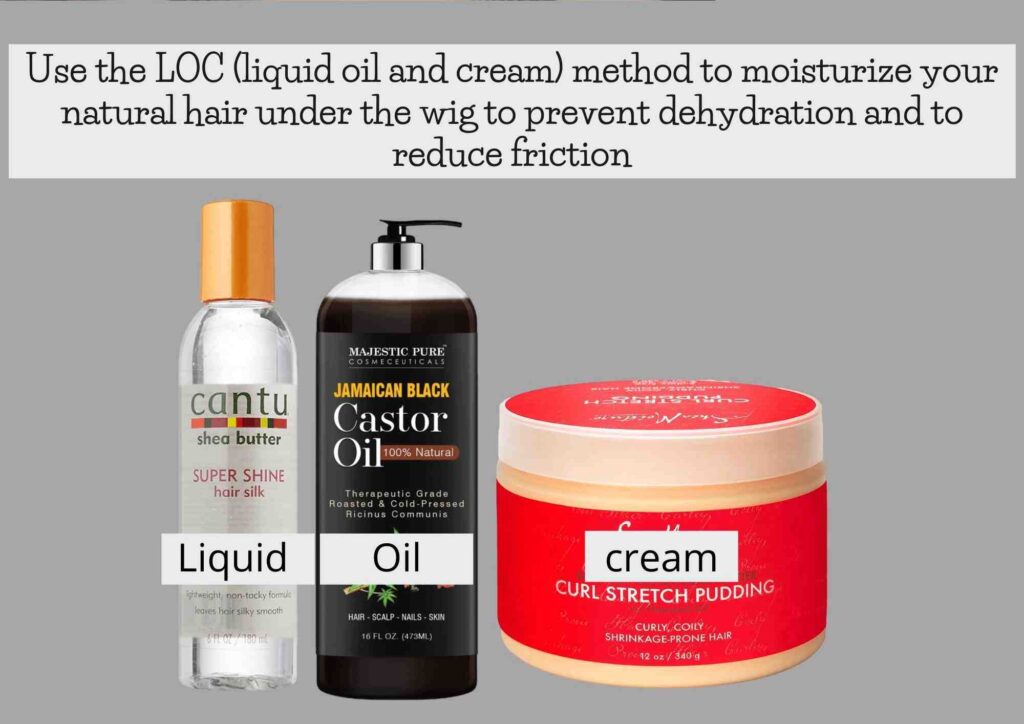
I’ve noticed a lot of women who start wearing wigs forget to take care of their natural hair. But please remember that natural hair requires the same amount of care, if not more as before you started wearing wigs.
The most fundamental part of caring for your Afro-textured hair is to ensure that it’s moisturized.
The structure of coily hair is such that it gets dry and frizzy too soon. So I suggest using the LOC method to keep your natural hair soft under your wig.
LOC stands for liquid, oil and cream and the method basically suggests you apply these 3 types of products in your curly, coily hair in that order.
So it would be a liquid leave-in conditioner or serum to add hydration to your hair, oil to lock the hair’s moisture in to add further nourishment, and finally a cream to prevent frizz and smoothen your curls.
Choose Wefted Wigs Over Other Types
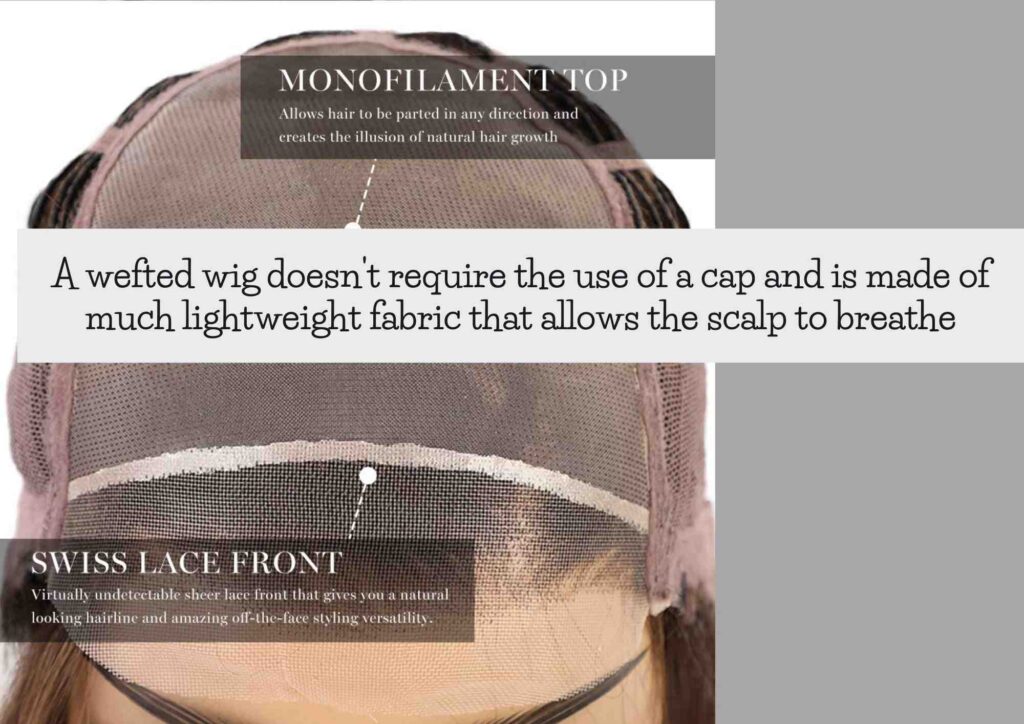
Now wigs are not all the same, and now I’m not talking about Remy hair vs synthetic hair or hair textures and types. I’m talking about the lining material used and how it’s constructed.
Wefted wigs are basically wigs that feature human or synthetic hair sewn over wig lining fabric in rows (similar to the way carpets are woven).
These wigs are much cooler on the scalp as they do not come with a wig cap and can let your scalp breathe.
The material is also lighter as it features fewer layers so your scalp isn’t going to get sweaty as often.
Take Breaks Between Wearing Wigs To Let Scalp Breathe
I get it wearing wigs is addictive but make sure to take small breaks in between to let your scalp breathe.
It might be something as simple as taking off your wig as soon as you get home or wearing a wig only for special occasions.
These small breaks can help air out your scalp and prevent sweat accumulation.
Do Not Wear Your Wig To Bed
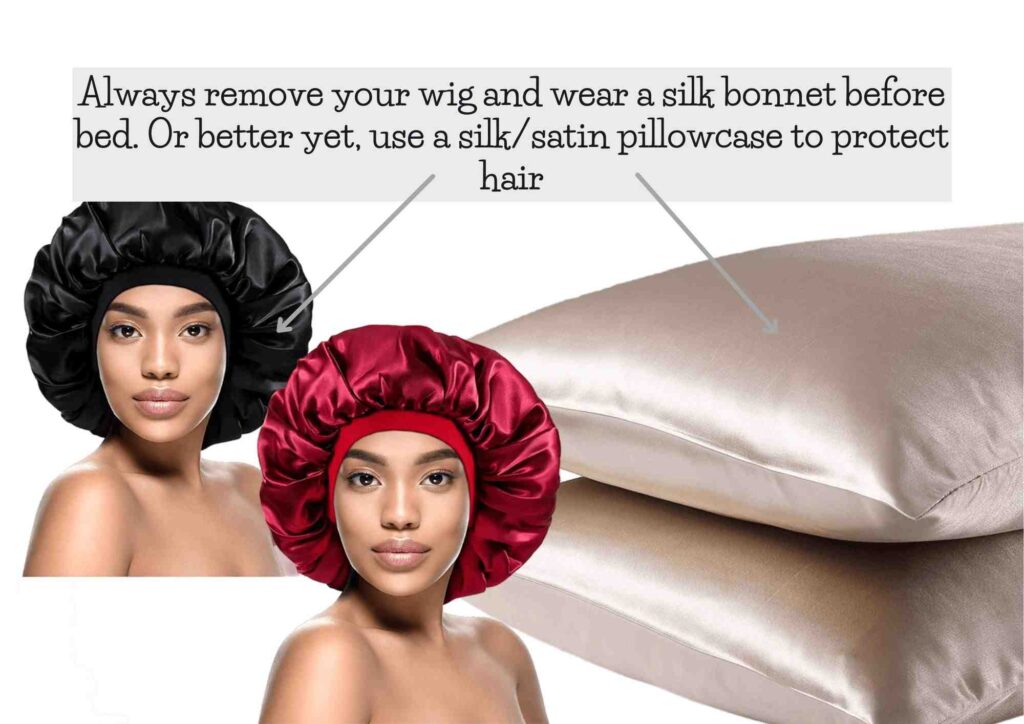
There are two reasons why you shouldn’t wear a wig to your bed. The first reason is that you need to give your hair a break from wearing wigs and let your scalp breathe.
The second reason is that the tossing and turning during your sleep can cause undue amounts of friction between your natural hair and the wig fabric.
So there is an increased chance that your hair will get damaged and even break off if you’re wearing a wig to bed.
I also do not recommend going to sleep bare-headed or on a cotton pillowcase if you have natural type 4 hair.
The friction between cotton fibers and your hair is too much and causes hair damage. Cotton is also very absorbent and can remove hair’s necessary moisture.
So use a silk bonnet to tuck your into before you go to sleep. Or invest in a silk or satin pillowcase that is non-absorbent and won’t chafe against hair cuticle.
Do Not Wear A Wig Over Damp Hair
This should go without saying but never ever wear a wig over damp hair.
Firstly, damp hair is more prone to breakage as the hair cuticle is in a weakened state. So any friction from the wig can cause split ends and damage.
Secondly, dampness is a breeding ground for bacteria and fungi. The combination of wet hair and your natural body heat and hours of wearing a sweaty wig is the perfect situation for a fungal infection to happen.
So if you don’t want mildew growing on your wigs, I’d really suggest you avoid this no matter how late you are getting.
Wear Your Natural Hair In Protective Hairstyles Like Braids
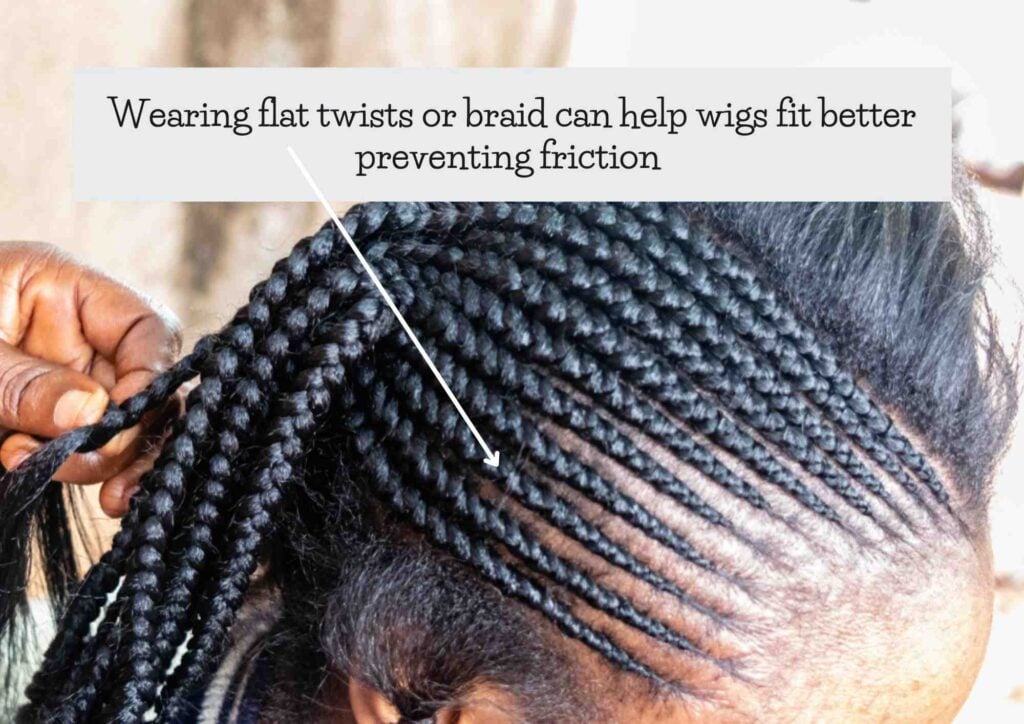
Now a lot of people are wary of putting braids underneath their wigs for fear of friction or breakage. But braids or other protective hairstyles like twists only become a cause of concern when you make them too tight.
I’m a huge fan of wearing braids or flat twists underneath a wig as they keep your natural hair out of the way and help a wig fit better on your scalp.
Wear A Cap Over Head Before Wearing A Wig
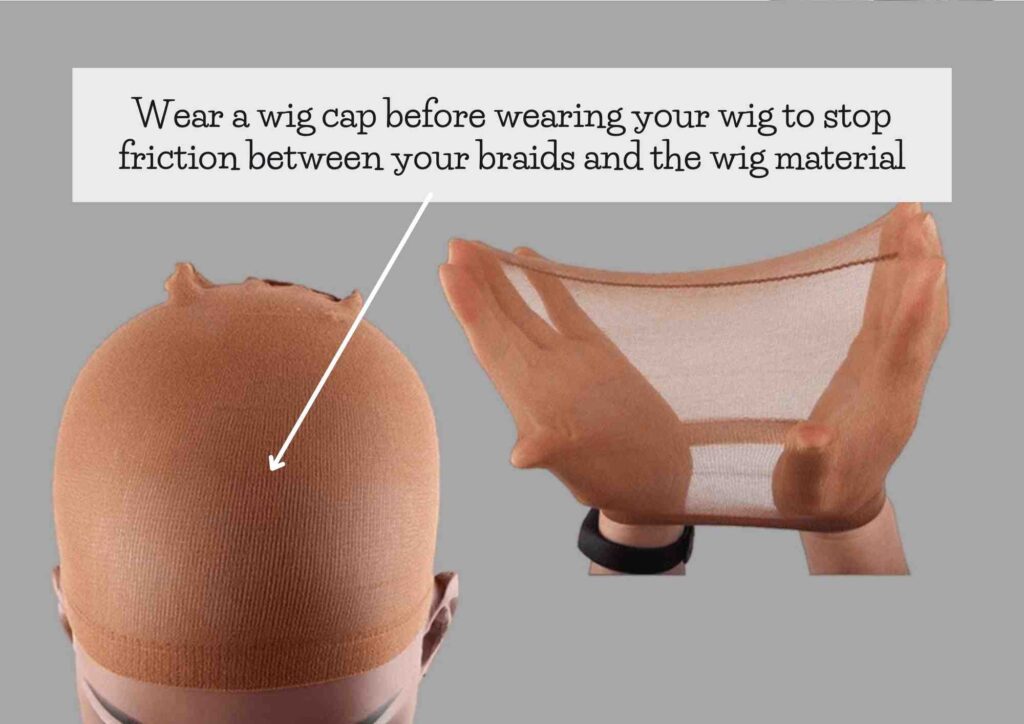
Now I know I’ve previously said a wefted wig is much better for your scalp health. And that’s true, of course. But if you’re wearing natural hair in braids underneath your wig, I’d suggest donning a cap before wearing a wig.
When you wear hair in braids your strands are already bound tightly due to the nature of the hairstyle. But then the friction between your hair and the wig material can lead to more tugging and pulling.
In worst cases, this can lead to traction alopecia that causes hair loss due to friction.
So a cap that fits tightly (but not too tightly that it cuts off blood circulation!) can help keep your braids in place and prevent them from moving around too much, reducing friction.
FAQs about Protecting Hair Under A Wig
Can your hair grow under a wig?
How to protect hairline when wearing a wig?
How do I keep my hair flat under a wig without braids?
Wigs can help women get different hairstyles when they are wearing protective braids or dreadlocks.
And in this article above I’ve listed out several ways to help you protect hair from damage and scalp from health issues when wearing wigs for longer periods.
But just like any other hair styling accessory wigs need proper maintenance too. So it’s also essential that you use the proper wig cleaners, shampoos, and hair styling products like hair sprays on your wigs.
I also suggest investing in a high-quality lace front wig and a wig cap as these are not the accessories you skimp on.



